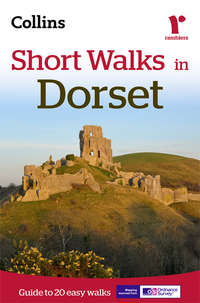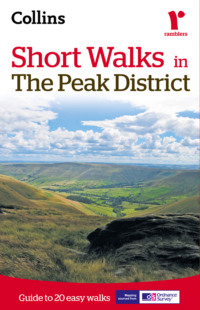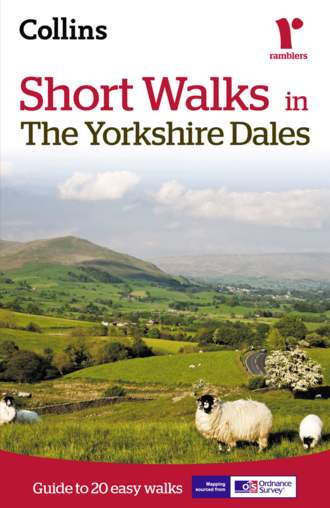
Полная версия
Short walks in the Yorkshire Dales

Short Walks in
The Yorkshire Dales

Contents
Cover
Title
Short Walk locations
Introduction
How to use this book

walk 1: Booze
3¼ miles (5.2km)
walk 2: Muker & Thwaite
3 miles (4.8km)
walk 3: Semer Water
4 miles (6.4km)
walk 4: The Waterfalls of Aysgarth & West Burton
4¾ miles (7.6km)
walk 5: Hardraw Force
3½ miles (5.6km)
walk 6: Hell Gill
4¾ miles (7.6km)
walk 7: Winder
4¾ miles (7.6km)
walk 8: Sedbergh & River Rawthey
4½ miles (7.2km)
walk 9: Middleham
2½ miles (4km)
walk 10: Coverdale
4½ miles (7.2km)
walk 11: Kettlewell & Starbotton
5½ miles (8.8km)
walk 12: Ghaistrill’s Strid & Grass Wood
4½ miles (7.2km)
walk 13: Malham Cove & Gordale Scar
4¾ miles (7.6km)
walk 14: Simon’s Seat
4 miles (6.4km)
walk 15: Attermire Scar
4½ miles (7.2km)
walk 16: Pen-y-ghent
6 miles (9.7km)
walk 17: Upper Littondale
5 miles (8km)
walk 18: Central Swaledale
3 ¾ miles (6km)
walk 19: Ingleton’s Waterfalls
4¾ miles (7.6km)
walk 20: Chapel-le-Dale
3½ miles (5.6km)
Photo credits
Copyright
About the Publisher
walk 1, walk 2, walk 3, walk 4, walk 5, walk 6, walk 7, walk 8, walk 9, walk 10, walk 11, walk 12, walk 13, walk 14, walk 15, walk 16, walk 17, walk 18, walk 19, walk 20
Introduction
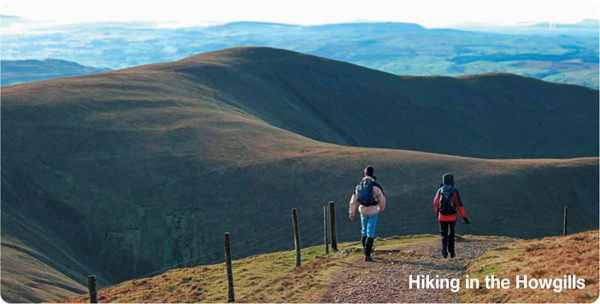
Walking in the Yorkshire Dales
People have walked the Yorkshire Dales almost since the first man appeared on our shores. Prehistoric hunters followed regular routes along grassy ridges and across the broad cols connecting individual dales. Later, the Romans built their roads, some of which are now used by modem traffic. Others are still recognisable as stony tracks across the fells. Drovers and packhorsemen, the ancestors of today’s long-distance lorry drivers, created green roads which can be traced for miles across the wild central moors. Corpse roads linking outlying hamlets to sanctified ground miles down the dale still exist but it is perhaps the local footpaths, connecting villages and farmsteads, which will give the most pleasure to a walker in the Dales.
Walking is a pastime which can fulfil the needs of everyone. You can adapt it to suit your own preferences and it is one of the healthiest of activities. This guide is for those who just want to walk a few miles. It really doesn’t take long to find yourself in some lovely countryside. Most of the walks are five miles or less so should easily be completed in under three hours. Walking can be anything from an individual pastime to a family stroll, or maybe a group of friends enjoying the fresh air and open spaces of our countryside. There is no need for walking to be competitive and, to get the most from a walk, it shouldn’t be regarded simply as a means of covering a given distance in the shortest possible time.
What are the Yorkshire Dales ?
The Central Pennines are cut by a series of valleys which have become known as the Yorkshire Dales. Radiating from a watershed on the mass of high ground north and east of Ribblehead, five rivers, the Swale, Ure, Nidd, Wharfe and Aire, eventually flow east into the North Sea by way of the Ouse and Humber. Three others, the Ribble, Lune and Eden, all enter the Irish Sea, to the west, as independent rivers. All have their birth on the gritstone cap of the central moors but, with the exception of the Nidd and Lune, they all flow for at least their middle sections through countryside based upon limestone. As a result, the rivers have carved deep clefts through the soluble limestone rock to reach harder, watertight shales and slates.
Every dale has its own character. In the north, Swaledale is the wildest, a deep-cut gorge below rolling heather moors, joined at Reeth by its even wilder tributary, Arkengarthdale, where the dale begins to take on a gentler aspect. Villages of stone-built cottages line its northern banks. Place names can be traced to the early Viking settlers.
The next east-flowing dale is Wensleydale, the only one which does not take its name from its river, in this case the Ure. Wensleydale was once filled by a glacial lake and its flatter valley bottom and wider aspect is the result. Lush meadowlands feed the dairy cattle which produce milk for the famous Wensleydale cheese. The dale is renowned for its waterfalls but less appreciated features are in its four side dales, all roughly parallel to each other, flowing from the south-west. These often secluded valleys will reward anyone who wants to explore their secrets.
Next is Nidderdale, a little-known dale to the east of Wharfedale, where the strangely-worn shapes of Brimham Rocks cut into the skyline. Nidderdale is not part of the Yorkshire Dales National Park.
Wharfedale and Airedale, with their ease of access from the West Riding, are probably the best known dales. Wharfedale, wooded in its lower reaches, is lined with dramatic limestone formations and attractive villages, a feature echoed by its tributary, Littondale, for all except its sombre headwaters. Airedale’s Malham Cove, an amphitheatre of solid limestone, is an outstanding feature of the Dales. A tributary of the Aire flows from its base – the main river still flows underground at this point. The ravine of Gordale Scar, a ‘roofless’ cave, is close by.
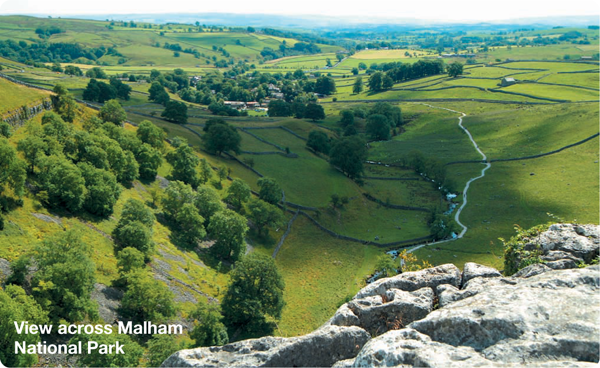
Of the western dales, Ribblesdale is essentially a limestone dale separating the three highest summits of the Dales: Whernside, Ingleborough and Pen-y-ghent. Like the other northern rivers which flow into the Irish Sea, its waters are clean enough to welcome sea trout and salmon. It is the Lune’s tributaries, Dentdale and Garsdale which are completely within the boundaries of the National Park, the main dale mostly skirting the north-west edge. Of the Eden, only its highest tributary, Hell Gill with its fantastic ravine, is within the park, its headwaters forming the county boundary of Cumbria and North Yorkshire, a boundary followed by the National Park.
The earliest settlers in the Dales were the hunters who lived in caves such as Victoria Cave above Settle, where the remains of reindeer and bones of grizzly bears have been found, animals which lived on the tundra-like conditions following the Ice Age. With the Roman invasion, roads began to appear across the fells and forts were built to control lead mining areas. Lead increased in value with the expansion of building from Roman times, through the height of monastic power right up to the 19th century when cheaper imports killed off the local industry with devastating effect. Remains of the old lead mines and their smelt houses can still be found on the moors above Swaledale and Wensleydale in the north and near Grassington in the south.
Monasteries developed in the Middle Ages to cement an enforced peace made after the Norman Conquest. With their power, which only ended with the Dissolution in the 16th century, they exploited the riches of the lead mines and encouraged the development of vast flocks of sheep which roamed unhindered for miles across the fells, setting the scene for farming patterns which have changed only in recent years. The next development to take place was the movement of animals and goods across the moors; animals were driven south from Scotland and the Dales by a tough breed of men known as drovers. These men slowly moved their charges to the rapidly growing industrial areas further south, by routes which can still be traced to this day. Many of the old drove roads and pack-horse routes are still clearly defined as ‘green roads’, which snake for miles across the high fells and limestone plateaux of the Dales.
Geology
Almost 300 million years ago, the rocks which are now the lowest part of the Yorkshire Dales, existed as the muddy floor of a shallow tropical sea. Those muds became slates, the bedrock of many of the Dales’ rivers. Gradually the sea filled with the teeming life of tiny crustaceans living amongst long-stemmed waterlily-like plants, called crinoids. As these plants and animals died, their bodies and shells sank slowly to the bottom of the sea, consolidating to form the colossal limestone cover which features so predominantly throughout the Dales. Much later, a huge river delta began to fill this sea, its outer deposits spreading to form shales, and on top of them came the harder gritstones, now the top-most rocks of the highest peaks.
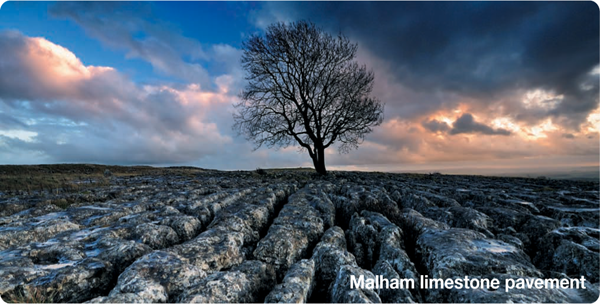
As all this building up and smothering was taking place, land masses moved and gradually the land which was once in the tropics moved north towards its present position. During all this activity, faults occurred in the surface of the land and the rocks were pushed up and down; Malham Cove is a good example of a fault line appearing at the surface.
While the land was beginning to settle into its present shape, subterranean activity forced hot mineral solutions of ores into narrow cracks in the upper rocks. These mineral solutions were mostly lead but there were traces of silver and even gold. Chemical reactions formed calcium fluoride, which was a nuisance to later miners but is a useful raw material today. To the north, vast upsurges of volcanic dolerite created the great Whin Sill.
Around 10,000 years BC, the land, though covered by ice, was beginning to take on the outline of the Dales as we know them. As the ice melted, moraine dams created lakes in areas such as Upper Wensleydale. Mud made from ground down rocks of the high tops began to form the basis of new strata and the process of wearing down and building up began again. In geological time 10,000 years is like a few minutes to us and, once the moraine dams were breached, those muds and clays began to form the basis of today’s rich pastures of the Central Dales. The process is continuing.
Wildlife in the Yorkshire Dales
Wildlife habitats follow closely-defined zonal limits; on the high tops of Ingleborough and Pen-y-ghent, habitats are restricted to mosses and a little grass with alpine flowers, such as purple saxifrage (saxifraga oppositifolia), living in tiny crevices and ledges on the limestone crags. Mountains with broader summits, such as Whernside, are able to support coarse grasses, with heather and bilberry dominating the grouse moors further south. Meadow pipits and ring ouzels frequent the higher slopes and the dipper follows streams high on the fell. Birds of prey such as kestrels, merlins and buzzards, as well as the ubiquitous crow, can be found on most of the quieter fells. Mountain hares are often seen gambolling on the open hillsides. Even though standing water is rare on the normally dry cols and ridges, sea-birds, such as blackheaded gulls, nest far from their ‘official’ home. For centuries, the land below the 1,700 foot (520m) contour, has been improved for sheep grazing and true native grasses and rushes will only be found in areas of poor husbandry and under-grazing. Mountain pansy (viola lutea), rock rose (helianthemum chamaecistus) and thyme (thymus serpyllum), grow on sparse limestone soils. Limestone pavements are cracked and fissured by ‘grikes’ where the shade-loving plants such as dog’s mercury (mercuriatis perennis) and hart’s tongue fern (phyllitis scolopendi) are the remains of ground cover of native ash woods which covered the Dales before the last Ice Age.

Where the riverbanks are uncultivated, natural woodland takes advantage of the rich damp soil and woodland flowers grow in profusion. Many of the rivers have excellent fish stocks but the best by far are the Lune and Ribble and their tributaries. Both main rivers manage to enter the Irish Sea relatively unpolluted and, as a result, are visited by migrant trout and spawning salmon.
The Yorkshire Dales National Park
In many other countries, National Parks are wilderness areas, where few people live unless they are connected with running the park. Countries such as the United States of America have even gone to the length of moving residents off land designated as a National Park. In England and Wales, National Parks are areas of outstanding beauty where people still live and work. One of the major functions of a National Park is to preserve the landscape and the livelihoods of the people living within its boundaries. This is achieved by careful planning control. The National Parks and Access to the Countryside Act of 1949 led to the formation of National Parks in England and Wales.
The word ‘National’ in the title sometimes leads to misunderstanding. National Parks are not nationalised or in any way owned by the government.
The Yorkshire Dales National Park was designated in 1953 and covers an area of approximately 683 square miles (1769 square km). It is administered by the Yorkshire Dales National Park Authority. The Authority is made up of representatives from the local county and district councils as well as members appointed by the Secretary of State for the Environment, (Defra).
Large areas of grouse moorland, mainly in the south of the Park, are held by the Chatsworth Estates Trust for the Duke of Devonshire. Rights of Way cross several of the moors but, most importantly, the estate allows free access to Barden and Simonseat Moors above Bolton Abbey on either side of Wharfedale. This means that walkers have the right to roam freely over the moors on all but publicised days during the shooting season or during periods of high fire risk. This concession is one which must be respected by all users.
One of the statutory functions of a Park Authority is the appointment of full-time and voluntary Park Rangers. These are people with particular knowledge of some aspects of the local environment who are available to give help and advice to visitors.
Walking tips & guidance
Safety
As with all other outdoor activities, walking is safe provided a few simple commonsense rules are followed:
• Make sure you are fit enough to complete the walk;
• Always try to let others know where you intend going, especially if you are walking alone;
• Be clothed adequately for the weather and always wear suitable footwear;
• Always allow plenty of time for the walk, especially if it is longer or harder than you have done before;
• Whatever the distance you plan to walk, always allow plenty of daylight hours unless you are absolutely certain of the route;
• If mist or bad weather come on unexpectedly, do not panic but instead try to remember the last certain feature which you have passed (road, farm, wood, etc.). Then work out your route from that point on the map but be sure of your route before continuing;
• Do not dislodge stones on the high edges: there may be climbers or other walkers on the lower crags and slopes;
• Unfortunately, accidents can happen even on the easiest of walks. If this should be the case and you need the help of others, make sure that the injured person is safe in a place where no further injury is likely to occur. For example, the injured person should not be left on a steep hillside or in danger from falling rocks. If you have a mobile phone and there is a signal, call for assistance. If, however, you are unable to contact help by mobile and you cannot leave anyone with the injured person, and even if they are conscious, try to leave a written note explaining their injuries and whatever you have done in the way of first aid treatment. Make sure you know exactly where you left them and then go to find assistance. Make your way to a telephone, dial 999 and ask for the police or mountain rescue. Unless the accident has happened within easy access of a road, it is the responsibility of the police to arrange evacuation. Always give accurate directions on how to find the casualty and, if possible, give an indication of the injuries involved;
• When walking in open country, learn to keep an eye on the immediate foreground while you admire the scenery or plan the route ahead. This may sound difficult but will enhance your walking experience;
• It’s best to walk at a steady pace, always on the flat of the feet as this is less tiring. Try not to walk directly up or downhill. A zigzag route is a more comfortable way of negotiating a slope. Running directly downhill is a major cause of erosion on popular hillsides;
• When walking along a country road, walk on the right, facing the traffic. The exception to this rule is, when approaching a blind bend, the walker should cross over to the left and so have a clear view and also be seen in both directions;
• Finally, always park your car where it will not cause inconvenience to other road users or prevent a farmer from gaining access to his fields. Take any valuables with you or lock them out of sight in the car.
Equipment
Equipment, including clothing, footwear and rucksacks, is essentially a personal thing and depends on several factors, such as the type of activity planned, the time of year, and weather likely to be encountered.
All too often, a novice walker will spend money on a fashionable jacket but will skimp when it comes to buying footwear or a comfortable rucksack. Blistered and tired feet quickly remove all enjoyment from even the most exciting walk and a poorly balanced rucksack will soon feel as though you are carrying a ton of bricks. Well designed equipment is not only more comfortable but, being better made, it is longer lasting.
Clothing should be adequate for the day. In summer, remember to protect your head and neck, which are particularly vulnerable in a strong sun and use sun screen. Wear light woollen socks and lightweight boots or strong shoes. A spare pullover and waterproofs carried in the rucksack should, however, always be there in case you need them.
Winter wear is a much more serious affair. Remember that once the body starts to lose heat, it becomes much less efficient. Jeans are particularly unsuitable for winter wear and can sometimes even be downright dangerous.
Конец ознакомительного фрагмента.
Текст предоставлен ООО «ЛитРес».
Прочитайте эту книгу целиком, купив полную легальную версию на ЛитРес.
Безопасно оплатить книгу можно банковской картой Visa, MasterCard, Maestro, со счета мобильного телефона, с платежного терминала, в салоне МТС или Связной, через PayPal, WebMoney, Яндекс.Деньги, QIWI Кошелек, бонусными картами или другим удобным Вам способом.




